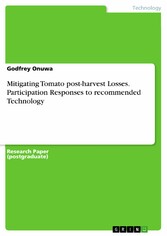Mitigating Tomato post-harvest Losses. Participation Responses to recommended Technology
von: Godfrey Onuwa
GRIN Verlag , 2021
ISBN: 9783346356536
, 51 Seiten
Format: PDF
Kopierschutz: frei
Preis: 18,99 EUR
eBook anfordern 
Mehr zum Inhalt

Mitigating Tomato post-harvest Losses. Participation Responses to recommended Technology
Research Paper (postgraduate) from the year 2020 in the subject Food Technology, Federal University of Technology, Owerri, language: English, abstract: This study investigated the economics of post-harvest losses among tomato farmers in Barkin-Ladi Local Government Area of Plateau State, Nigeria. Multi-stage sampling techniques were used in selecting respondents for this study. Primary data was collected using structured questionnaires. Descriptive statistics, Likert method and ordinary least square regression model; were analytical techniques employed. The result revealed that 62% of the respondents were males, 72% are married. The mean age was 42 years. Most (38%) attained primary education, 48% had a household size with population of 1-5 people. The mean year of experience was 17 years. Most (78%) used woven baskets in packaging their produce. The prevalent improved post-harvest techniques were; appropriate harvesting techniques (2.79), improved drying techniques (2.69) and improved processing technology (2.62) as indicated by their significant mean scores. The estimated value of tomato post-harvest loss per 50kg was 27.5%. Thus, estimated gross margin were ?5,400 (without loss) and ?3,910 (with loss) respectively. The coefficients of farming experience (-0.421), distance to markets (0.413), age of fruit at harvest (0.519), quantity of fruits harvested (0.387) and post-harvest practices (-0.396) were statistically significant at 5% level. The estimated coefficient of multiple determination (R2) was 0.795, suggesting that 79% of post-harvest losses were attributable to the variables in the regression model. The constraints identified affected tomato post-harvest loss reduction. Adoption of improved post-harvest techniques, storage and processing facilities, provision of improved market linkages and access to agricultural credit, extension contact and formation of producer cooperatives are strongly recommended for reduced wastages.













